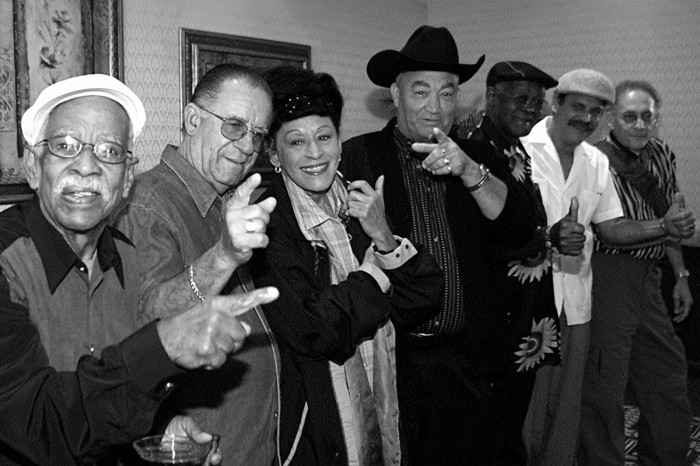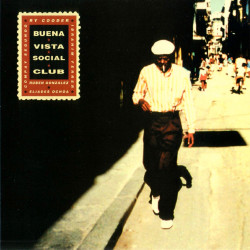
Buena Vista Social Club
A favorite of
Darren Farnsworth
Select Songs
'El Cuarto de Tula'
Music Spotify YouTube
Posted 04.21.2021
'Dos Gardenias'
Music Spotify YouTube
Posted 09.09.2018
Cubano
Buena Vista Social Club is an ensemble of Cuban musicians established in 1996 to revive the music of pre-revolutionary Cuba. The project was organized by World Circuit executive Nick Gold, produced…
Buena Vista Social Club is an ensemble of Cuban musicians established in 1996 to revive the music of pre-revolutionary Cuba. The project was organized by World Circuit executive Nick Gold, produced by American guitarist Ry Cooder and directed by Juan de Marcos González. They named the group after the homonymous members' club in the Buenavista quarter of Havana, a popular music venue in the 1940s. To showcase the popular styles of the time, such as son, bolero and danzón, they recruited a dozen veteran musicians, many of whom had been retired for many years.
The group's eponymous album was recorded in March 1996 and released in September 1997, quickly becoming an international success, which prompted the ensemble to perform with a full line-up in Amsterdam and New York in 1998. German director Wim Wenders captured the performance on film for a documentary—also called Buena Vista Social Club—that included interviews with the musicians conducted in Havana. Wenders' film was released in June 1999 to critical acclaim, receiving an Academy Award nomination for Best Documentary feature and winning numerous accolades including Best Documentary at the European Film Awards. This was followed up by a second documentary Buena Vista Social Club: Adios in 2017.
The success of both the album and film sparked a revival of interest in traditional Cuban music and Latin American music in general. Some of the Cuban performers later released well-received solo albums and recorded collaborations with stars from different musical genres. The "Buena Vista Social Club" name became an umbrella term to describe these performances and releases, and has been likened to a brand label that encapsulates Cuba's "musical golden age" between the 1930s and 1950s. The new success was fleeting for the most recognizable artists in the ensemble: Compay Segundo, Rubén González, and Ibrahim Ferrer, who died at the ages of ninety-five, eighty-four, and seventy-eight respectively; Compay Segundo and González in 2003, then Ferrer in 2005.
Several surviving members of the Buena Vista Social Club, such as veteran singer Omara Portuondo, trumpeter Manuel "Guajiro" Mirabal, laúd player Barbarito Torres and trombonist and conductor Jesús "Aguaje" Ramos currently tour worldwide, to popular acclaim, with new members such as singer Carlos Calunga and pianist Rolando Luna, as part of a 13-member band called Orquesta Buena Vista Social Club.
The original Buenavista Social Club
Abandoned building in Almendares, Marianao, that housed the Buenavista Social Club in the 1940s.
The Buenavista Social Club was a members-only club originally located in Buenavista (literally fair view), a quarter in the current neighbourhood of Playa (before 1976 part of Marianao), one of the 15 municipalities in Cuba's capital, Havana. The original club was founded in 1932 in a small wooden venue at calle Consulado y pasaje "A" (currently calle 29, n. 6007). In 1939, due to lack of space the club relocated to number 4610 on Avenue 31, between calles 46 and 48, in Almendares, Marianao. This location is recalled by Juan Cruz, former director of the Marianao Social Club and master of ceremonies at the Salón Rosado de la Tropical (other nightclubs in Havana). As seen in the Buena Vista Social Club documentary, when musicians Ry Cooder, Compay Segundo and a film crew attempted to identify the location of the club in the 1990s, local people could not agree on where it had stood.
At the time, clubs in Cuba were segregated; there were sociedades de blancos (white societies), sociedades de negros (black societies), etc. The Buenavista Social Club operated as a black society, which was rooted in a cabildo. Cabildos were fraternities organized during the 19th century by African slaves. The existence of many other black societies such as Marianao Social Club, Unión Fraternal, Club Atenas (whose members included doctors and engineers), and Buenavista Social Club, exemplified the remnants of institutionalized racial discrimination against Afro-Cubans. These societies operated as recreational centers where workers went to drink, play games, dance and listen to music. In the words of Ry Cooder,
Society in Cuba and in the Caribbean including New Orleans, as far as I know, was organized around these fraternal social clubs. There were clubs of cigar wrappers, clubs for baseball players and they'd play sports and cards—whatever it is they did in their club—and they had mascots, like dogs. At the Buena Vista Social Club, musicians went there to hang out with each other, like they used to do at musicians' unions in the U.S., and they'd have dances and activities.
As a music venue, the Buenavista Social Club experienced the peak of Havana's nightclub life, when charangas and conjuntos played several sets every night, going from club to club over the course of a week. Often, bands would dedicate songs to the clubs where they played. In the case of the Buenavista Social Club, an eponymous danzón was composed by Israel López "Cachao" in 1938, and performed with Arcaño y sus Maravillas. In addition, Arsenio Rodríguez dedicated "Buenavista en guaguancó" to the same place. Together with Orquesta Melodías del 40, the Maravillas and Arsenio's conjunto were known as Los Tres Grandes (The Big Three), drawing the largest audiences wherever they played. These vibrant times in Havana were described by pianist Rubén González, who played in Arsenio's conjunto, as "an era of real musical life in Cuba, when there was very little money to earn, but everyone played because they really wanted to".
Source Wikipedia










